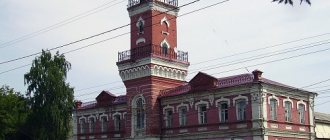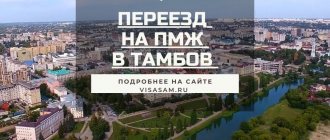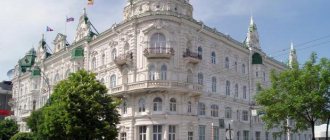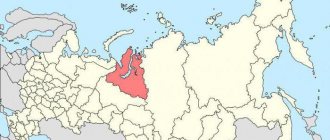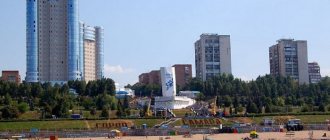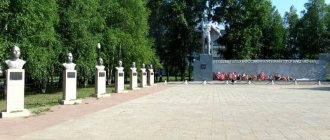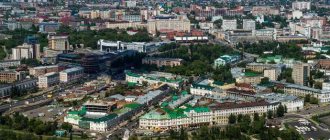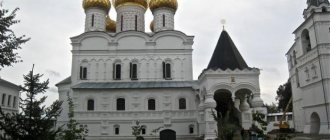For a city located just 10 km. from the Moscow Ring Road, Zheleznodorozhny offers surprisingly inexpensive housing. To find out what the catch is, the portal KVARTIRAzaMKAD.ru went on the spot to assess living conditions and select the best new buildings in Zheleznodorozhny.
Zheleznodorozhny is located in the eastern part of the Moscow region, 10 km. from the Moscow Ring Road along Nosovikhinskoye Highway. More than 150 thousand people live on its territory of 2,408 hectares. Every year the number of residents increases by approximately 2,500 people. In 2015, Zheleznodorozhny lost its city status, becoming part of the city of Balashikha, however, this does not seem to have affected its development and functioning. The former municipal facility remains quite isolated and self-sufficient, and also has a number of features that should be considered separately from Balashikha.
On the Moscow side, the closest neighbors are Reutov, Saltykovka and Balashikha. Further along the Nosovikhinskoe highway, Elektrougli and Pavlovsky Posad. To the south are Lyubertsy and many villages and SNT.
general information
Zheleznodorozhny is currently part of the city of Balashikha in the Moscow region of Russia, which until almost the end of 2014 was a separate city of regional subordination and the administrative center of the city district of the same name. It has been an independent city since 1952, and since 1960 it has become a city of regional subordination. The population of the city of Zheleznodorozhny, Moscow region, was approximately 152,000 people in 2015. The population density (in the same year) was 6311.67 people/km2.
The area occupied by the settlement at the time of unification was 2408 hectares. The former city stretches from west to east for a distance of 7 km, but if we take into account the Kupavna microdistrict built remotely, then for 13 km. The Moscow-Nizhny Novgorod railway line runs through the territory; the station (previously considered the city center) is located 10 km east of the Moscow Ring Road. Nearby cities: the city of Balashikha was 8 km away, Reutov was 10 km away, and Lyubertsy was 11 km away.
After joining the Balashikha urban district, the city was divided into 8 microdistricts: the central districts of the abolished city formed the Zheleznodorozhny district. Keramik, Kupavna, Kuchino, Olgino, Pavlino, New Pavlino and Savvino were also identified.
Review of new buildings in the city of Zheleznodorozhny
Several years ago, massive residential development began in Zheleznodorozhny. Moreover, a monopoly is flourishing here in the person of the developer Skopa Real Estate, which has several completed complexes and queues, new projects throughout the city and a wide portfolio of infrastructure facilities.
The average price tag for new buildings at the construction stage is 60 thousand rubles per sq. m. m. The price range for one-room apartments is from 2.9 million rubles, for two-room apartments - from 4.1 million rubles, and three-room apartments - from 5.9 million rubles. More expensive than 7 million rubles. There are practically no apartments in new buildings in Zheleznodorozhny, and an attractive price is the main argument of most developers, especially since all the projects here are exclusively economy and comfort class. Let us consider the residential complexes actively under construction on the territory of Zheleznodorozhny and their features.
The largest residential complex project (ZhK) has a good location relative to the highway and station (you can get there in 15 minutes on foot). Panel houses are being built by different organizations - GC "PIK" and "DSK 1". The complex already has several populated areas with their own social infrastructure and commercial premises on the ground floors.
True, the impression is greatly spoiled by the high density of buildings. It’s quite easy to get confused in identical cases that differ only in color combinations. Most of the courtyards are occupied by fenced areas of children's institutions. This could be a kindergarten, a school or a complex with a swimming pool. Along the inner perimeter there is a passage for cars, along which everything is occupied by cars - and this is in the middle of the working day! It’s hard to imagine where those returning from work in the evening park. Many residents are dissatisfied with the proximity to an abandoned hospital, where drunken groups and drug addicts find shelter.
There are 6 buildings under construction with a completion date of the end of 2021. However, the development potential is much greater - behind the new blocks there is ready space for further houses. Depending on the readiness status, the cost per sq. m. m ranges from 60 to 89 thousand rubles as of November 2021. Apartments are sold both with and without finishing.
Buildings under construction in the Center Plus residential complex
Completed blocks of the Center Plus residential complex
There are three new buildings in the Olgino microdistrict. The Chaika residential complex and the Central Quarter residential complex from the Skopa developer are being built opposite each other not far from the station. These are monolithic brick houses similar to each other with an assortment of apartments without finishing.
In buildings under construction, the price tag starts from 67 thousand rubles. per sq. m, and in the building of the Chaika residential complex that is being prepared for delivery from 81 thousand rubles. There is also potential for further development of the territory here, because in the neighborhood there are two-story wooden apartment buildings that are crumbling before our eyes and are subject to resettlement. However, there is no official information yet.
To get to the Olgino Park residential complex from the developer GVSU-Realty, you need to walk through several blocks of the private sector. And although visually it is located on the outskirts of the urban environment, transport accessibility here is more convenient than even in the residential complex “there are 2 minibuses and a bus, it is convenient to get to Nosovikhinskoye Highway. To get to the Center Plus residential complex, you have to drive through narrow streets and overcome several traffic lights, or make your way through winding paths through neighborhoods, because... There is only one minibus going to the complex so far.
In the Olgino Park residential complex, 7 panel buildings (111M) were recently built and received permission to be put into operation. At the same time, the price tag is quite affordable from 62 to 89 thousand rubles. per sq. m in apartments with rough finishing. At the moment, a school is being built on the territory of the complex and the courtyard is being landscaped.
True, residents express concern that the school is designed for primary grades, and instead of a kindergarten, there is a nursery on the ground floor of one of the houses. And due to the high workload of all educational institutions in Zheleznodorozhny, it will be problematic to place a child. But here there is one of the most comfortable environmental conditions - Olginsky Park is within walking distance, and the wind rose eliminates the negative impact on the area in the event of emissions from Rockwool enterprises.
Residential complex "Central Quarter"
Residential complex "Chaika"
Residential complex "Olgino Park"
Two residential complexes are being built in the northeastern part of the city. It was here that I happened to inhale smoke, so it will be more difficult to objectively assess the situation. The Stolichny residential complex is being built by the Glavstroy Development corporation literally in an open field and in the future will become a large self-sufficient microdistrict. There are planned 34 monolithic brick multi-storey buildings and a full range of infrastructure.
Delivery of the first stage is scheduled for the end of 2021. The cost starts from 2.5 million rubles for a one-room apartment with an area of 32 square meters. m. Price range 65 – 85 thousand rubles. per sq. m. Apartments are sold fully furnished. An advantage of the complex is the walking distance to city infrastructure and the station.
Residential complex "Stolichny"
Another project from Skopa Real Estate, a panel residential complex in the Savvino microdistrict, consists of two buildings. The entire microdistrict does not have the most advantageous location, because... on one side it is sandwiched by industrial zones on both sides, and on the third side by a wasteland and a cemetery. There are problems here both with the environment and with transport accessibility - it’s a long walk to the station, and there are traffic jams by ground transport. However, this is reflected in the price tag from 2.3 million rubles. for a one-room apartment without finishing. Average cost per sq. m - 60 thousand rubles.
There is also one business-class new building project in Zheleznodorozhny, which is being built surrounded by forest and with its own pond on the territory. This is a low-rise residential complex "Priozerny" with cottages and two-story monolithic brick houses with 8 apartments each.
The residential complex is located on the other side of the railway tracks, which will have to be crossed whenever urban infrastructure is needed. There is only one type of apartment in the Priozerny residential complex - two-room apartments with a footage of 65-77 sq. m. m with an open plan. The price range as of November 2021 is 66 – 77 thousand rubles. per sq. m. Delivery is scheduled for the end of 2021.
Near the conventional border of Zheleznodorozhny, in the village of Pavlino, the large-scale project Novograd “Pavlino” is being built. There is a huge range of offers from studios to three-room apartments, a variety of layouts and finishing options (rough/finish/turnkey). In this regard, the price tag varies from 56 to 79 thousand rubles. per sq. m. The smallest studio can be bought for 1.9 million rubles. The low price compensates for the remoteness of the residential complex from the highway, station and city infrastructure.
origin of name
Until 1939, the settlement bore the rather unsightly name Obiralovka. According to the most decent version, it comes from the name of one of the owners or founders of the settlement.
However, the population of the city of Zheleznodorozhny considers the more “romantic” version justified. In the century before last, a “exile route” ran through small villages, later united into a city. Along it, those sentenced to exile to distant Siberia walked on foot to serve their sentence. Local residents, who traded in robbery and theft on the high road, took away the last property from the prisoners. To the point where they took off their last clothes, that is, they robbed them. According to another similar version, the city received its name due to the fact that the same local murderers robbed merchants. The robbers hid in roadside forests and ravines, stopping merchants and, for the most part, surrounding peasants. They completely robbed them, unharnessed their horses and, for the time being, safely disappeared with the loot.
At that time, the best places for ambushes were on the Vladimirskaya and Nosovikhinskaya roads. Dense, impenetrable forests with wild animals and clouds of midges over numerous swamps have long served as a reliable refuge for bandits. On the Vladimir road, laid along the outskirts of the forest, many travelers were robbed, although there were no more than 20 miles to go to Moscow. It was much more dangerous to drive along the Nosovikhinskaya road, which wound through the thicket of the forest. Many travelers, robbed by dashing people in these places, began to call the villages in the surrounding area robbed. The offensive name stuck.
In 1939, the workers' settlement was given the name Zheleznodorozhny because the Moscow-Nizhny Novgorod railway ran nearby. Many residents use colloquial names - Zheldor or Zhelezka. In recent years, the colloquial Zhelik has become increasingly popular among the population of Zheleznodorozhny. Probably, for a long time the former districts of the city, now included in Balashikha, will be called this way.
Impressions and conclusions
Zheleznodorozhny has many advantages. It can be seen that the city (more precisely, since 2015, the Balashikha district) is developing, trying to catch up with the demand for modern infrastructure. The obvious disadvantages of Zheleznodorozhny are the unfavorable ecology, the congestion of the highway connecting the city with Moscow, and the high density of buildings, which turns some areas into an anthill. The main advantage is the affordable price of apartments and a wide range, both in the primary and secondary markets, taking into account that Moscow is only 30 minutes by train.
Zheleznodorozhny has great potential for further development, both within the urban environment on the site of dilapidated housing, and in the development of new territories. However, for now a ban on new construction has been introduced in Balashikha, and even without that, an excess of supply and moderate demand may turn out to be restraining factors for new construction.
Who can I advise to buy an apartment in Zheleznodorozhny? I think for people for whom proximity to Moscow and affordable prices are the determining factors, and other characteristics do not play a special role. Apartments in Zheleznodorozhny are also purchased by local residents who have become attached to their native land in order to improve their living conditions. Many consider the city as a good option for temporary residence, so the rental market here is much more active than the purchase and sale.
The best area to buy an apartment is Olgino or Central (in the vicinity of the Orion stadium). The most uncomfortable area of Savvino due to poor ecology and inconvenient transport accessibility. Residents are also advised not to prioritize city infrastructure and to look for new buildings in the surrounding areas of Kuchino microdistrict. MARZ, etc., where there are fewer environmentally polluting factors, and prices may be even lower.
Foundation of the city
The territory that was part of the modern city included the lands of Bogorodskoye, settlements (villages and hamlets) of the Vasilievskaya volost (Savvino, Obiralovka and others), as well as the Pekhorskaya volost of the Moscow district (Kuchino, Olgino). The oldest villages of Savvino and Kuchino are described in written sources from the time of the famous Russian prince Ivan Kalita, dated 1327. Moreover, Kuchino near the Pekhorka River was first mentioned as a wasteland. In 1571 the village of Troitskoye was founded. Each of the settlements developed independently for a long time. There is no reliable information about what kind of population lived in Zheleznodorozhny (more precisely, in the settlements that later became part of it) at that time.
In the second half of the 18th century, the village of Sergeevka arose. The settlement was founded by Count Pyotr Rumyantsev-Zadunaisky, who resettled several peasant families here, naming the settlement in honor of his youngest son. Over time, the official name was replaced by the colloquial nickname Obiralovka. So much so that by the end of the 19th century it became the official name of not only the village, but also the railway station. Obiralovka was first mentioned in 1799 in documents during the construction of the Nizhny Novgorod railway.
Development of the region in the 19th century
According to the directory of the Moscow province, published in 1829, which allows us to judge the size of the village, it had 6 households with 23 peasants. In 1852, another official document, which talked about the settlements of the Moscow region, recorded an increase in the number of residents. The population of Zheleznodorozhny (then the village of Sergeevka-Obiralovka) was 56 people, including 22 men and 35 women who lived in the same 6 courtyards.
In the second half of the 18th century, rapid development of the region's economy began, with the discovery and start of industrial development of clay deposits. At the beginning of the 19th century, local industrialists, the Danilov brothers, built the first red brick factory. Around the same time, the Moscow merchant Milovanov D.I. bought a small handicraft brick production and reorganized it into a brick production plant, which produced its first products in 1875. They began to invest money in profitable local businesses, and later brick factories of other merchants (including Kupriyanov and Golyadkin) were built. This industry provided jobs for the population of Zheleznodorozhny at that time for a long time.
Railway construction
In 1862, the Moscow-Nizhny Novgorod railway passed through the region, and the Obiralovka railway station was built. 15 years later, a station village arose nearby, which received the same name. In 1866, a well was built, the water supply of which was provided by a manual engine. Revenues generated at the station began to grow rapidly, and soon significantly exceeded costs. A water pumping station was built and the railway facilities were modernized. Freight and passenger traffic almost doubled. The station is assigned class 4, since all the necessary infrastructure already exists here: 4 switches, buildings for passengers and residential buildings. The station building had a telegraph office, a savings bank, a room with cash registers, a general waiting room, and special halls for the 1st and 2nd classes. The warehouse was built right behind the station, and there was also a post office here.
With the construction of the railway, industry received a powerful stimulus for development. The population of Zheleznodorozhny at that time began to grow rapidly; peasants who had received freedom after the abolition of serfdom began to be hired en masse at industrial enterprises.
In 1896, the grandson of the famous philanthropist Savva Morozov, manufacturer Vikula Morozov, built the Savvinskaya Manufactory factory. Next to it, factory workers founded a village called Savvino. In 1904, the second Aerodynamic Institute in the world and the first on the European continent was founded in the village of Kuchino. The scientific work was led by the founder of modern aerodynamics, professor at Moscow University N. E. Zhukovsky. The work of the institute gave impetus to the development of the village of Kuchino as a large scientific center. The small settlement has become famous among scientists and aeronautics enthusiasts in Russia and many countries around the world.
On the eve of the Revolution
The economic development of the region was highly dependent on the congestion of the railway. For the last quarter of a century, railroad tracks have been largely used to transport bricks. It was brought from local brick factories, many of which were built at the beginning of the 19th century. Other frequently transported goods were coal, firewood, and grain. In 1912, artificial lighting appeared at the station using kerosene lamps. The road management ensured exemplary order at the station and its surrounding area. The railway station was mentioned many times in literary works, for example, it was here that Anna Karenina, the heroine of Leo Tolstoy’s story, threw herself under a train.
The population in Zheleznodorozhny increased especially sharply in 1916; there were already about two hundred households in the settlement. The infrastructure also grew rapidly: a tea shop, a bakery and a hairdresser were opened. A small shop appeared where you could buy candles, inexpensive cigarettes and good groceries. A wine shop has opened. The first entertainment establishment appeared. Next to the local pond, which was rented by the contractor Maksimov, he built bathing facilities, and with the onset of winter, a skating rink was poured here, where those who wished were allowed to skate for a fee.
In 1916, a strong fire occurred in Obiralovka, which destroyed many commercial establishments. After this, a volunteer fire brigade consisting of local residents was organized in the village. A fire shed was equipped near the pond, on which an icon was hung, and a pillar with a signal bell was dug nearby. There was only one school in the village, where students studied for only three years. In terms of ethnic composition, the population of Zheleznodorozhny was quite homogeneous; mostly Russians lived here; in those days they were recorded in the census as Orthodox.
Infrastructure of Zheleznodorozhny
The shopping and entertainment segment in the city has been in a depressing state for a long time. As new residential areas appeared, modern complexes began to be built.
Most shopping centers are concentrated in the vicinity of the station. The most famous are “Union”, “Edelweiss” and “Edelweiss Plus”, “Podmoskovye”. Not long ago, the Orion sports complex opened with a swimming pool, stadium and sports grounds. In the center of Zheleznodorozhny, on the site of an old cinema, a new one is being built as part of the large Kristall shopping center.
It is curious that on the periphery of the city, where, in general, the building density is just as high, newly built commercial premises are without tenants. Although a new mixed-use complex is being built between the blocks of the Center Plus residential complex.
Shopping center with billiards and bowling in Zheleznodorozhny
Multifunctional complex "Crystal" under construction
SC "Orion"
In general, each quarter has its own economy markets and shops, beauty salons and fitness centers. There was even one large bookstore with an impressive assortment, stationery and a department for artists.
Some residents express dissatisfaction with the level of infrastructure development, especially in terms of leisure. Indeed, there is almost nowhere to walk, nowhere to go, no cultural objects. We can only hope that, following the rise of the retail segment, the entertainment segment will also catch up.
Attractive façade of the dumpling shop building
Stylized restaurant of oriental cuisine near the Chaika residential complex
With regard to social infrastructure in Zheleznodorozhny, residents face the same problems as in other cities of the Moscow region. It’s true that even taking into account the high population density, institutions can more or less cope with the load.
In new neighborhoods, it is mandatory to build their own children's institutions; in old neighborhoods, there are a sufficient number of schools and kindergartens, there are lyceums and specialized schools. But there are not so many leisure centers and creative schools. Mostly sports sections and the opportunity to go swimming (there are several swimming pools in the city).
School building in the Center Plus residential complex
Social infrastructure in the Center Plus residential complex
School in Zheleznodorozhny
The main complaint among residents is the quality of medical care. The inconvenience is that specialists are dispersed throughout the city in different departments of the clinic, and there are not so many institutions themselves for the ever-increasing population. A maternity ward was recently opened in the microdistrict. Savvino, but the center was attached to the region, not the city, so residents can only get there by direction from the district clinic.
Between two wars
After the Civil War, the first thing to do was restore the track facilities and rolling stock. During the years of industrialization and the first five-year plan, the electrification of the railway began. Since that time, a census of the inhabitants of the village of Obiralovka began to be carried out regularly; in 1929, 1000 people lived in it. Electricity work was completed a quarter ahead of schedule. In 1933, after a solemn meeting, the first electric train was sent from Obiralovka station to Moscow. The population grew rapidly due to the influx of specialists from different parts of the country, and the ethnic composition gradually began to change.
In 1939, the settlement received the status of an urban-type settlement, and at the request of the workers, as they wrote then, it was renamed the Zheleznodorozhny village. According to the last pre-war census, which took place in the same year, the population of Zheleznodorozhny, Moscow region, was 7,354 people. During the war years, many residents of the village were mobilized or volunteered to go to the front, six of them were awarded the title of Hero of the Soviet Union.
Comfort level in Zheleznodorozhny 11.9 out of 20
| Environmental characteristics | ||
| Green areas | 4 | 3.5 |
| Reservoirs | 4 | |
| Absence of serious sources of anthropogenic pollution | 2 | |
| Visual environment | 3 | |
| Connectivity of the city/region | ||
| Ease of movement within the city/region | 4 | 3.4 |
| Accessibility of Moscow by public transport | 3 | |
| Accessibility of Moscow by personal transport | 2 | |
| Communication with other localities | 4 | |
| Conditions for working within the city | 4 | |
| Social infrastructure | ||
| Kindergartens | 4 | 3.5 |
| Schools | 4 | |
| Children's leisure centers | 3 | |
| Cultural institutions | 2 | |
| Healthcare | 3 | |
| Sports and fitness | 5 | |
| Religious buildings | 3 | |
| Shopping and entertainment infrastructure | 4 | |
| Habitat quality | ||
| State of city utilities | 3 | 3.8 |
| Development of the real estate market | 5 | |
| Parking | 4 | |
| Accessibility for the disabled | 3 | |
| Risks and threats | ||
| Deteriorating transport situation | -2 | -2.3 |
| Underdevelopment of social infrastructure | -2 | |
| Deterioration of the environmental situation | -2 | |
| Oversaturation of the real estate market | -3 | |
Post-war years
In the post-war years, many industrial enterprises were built, and the region continued to specialize in the production of building materials. In 1946, a pilot production of ceramic blocks and a research institute for building ceramics were opened. In 1952, a wood processing plant opened its doors.
In the village of Savino, not far from the weaving factory, in 1947 a workshop was organized for the restoration of factory machine parts, which in 1956 was reorganized into an electromechanical plant. During these same years, an enterprise for the production of mineral wool products was built. To work at new industrial enterprises it was necessary to attract significant labor resources. Population of Zheleznodorozhny Mos. region in 1959 reached 19,243 people.
Obtaining city status
In 1952, the workers' settlement received the status of a city of regional subordination, and in 1960 it became a city of regional subordination. The structure then included the village of Sergeevka, a station village and several holiday villages: Afanasyevsky, Ivanovsky and Olgino. The history of the founding of these dachas is interesting.
Timber merchant Afanasyev bought the land from Prince Golitsyn. He built his own house (now the corner of Sovetskaya and Shmidt streets), laid out a central street in the forest, which he named in honor of his daughter Elizabeth, and several cross streets. He divided the space between the streets into small separate plots, which he sold at a good profit. By the 19th century, a whole dacha village of Afanasyevsky had formed, which later became part of the Pekhorskaya volost of the Moscow district.
In 1983, a Moscow tradesman and co-owner of a sawmill Ivanov I.K. bought a plot of land from the Peasant Society of the village of Pestovo. The landowner also initially developed the site, cut clearings for the streets, dug a pond and opened the sale of land plots. Since the first house in the new village belonged to Ivanov, it was nicknamed Ivanovsky. Then the name was shortened to Ivanovka, which became part of the Vasilyevskaya volost of the Bogoroditsky district.
The land plot on which the Olgino village was later built was purchased by industrialist F. M. Mironov (the main shareholder) in 1908 from Prince Golitsyn. The manufacturer gave the village to his wife Olga Gavrilovna for her birthday, which is why it received the name Olgino.
Automobile highways
The following roads pass through the city of Zheleznodorozhny:
- Nosovikhinskoye Highway is a regional highway that runs in the east of the Moscow region. The highway connects Moscow with holiday villages and cities in the east of the region. The total length of the route is 78 km. The road surface is asphalt concrete.
- MKAD - the city of Zheleznodorozhny borders the Moscow Ring Road. The distance from the city to the Moscow Ring Road is 7 km. The MKAD is a traffic-light-free road with a total length of 109 km. The road surface of the route is 109 km.
Soviet time
In 1960, several settlements were annexed to Zheleznodorozhny, including the villages of Savvino and Kuchino, the villages of Sergeevka and Temnikovo. By 1967, the population of the city of Zheleznodorozhny had grown to 48,000 people, more than doubling in eight years.
In subsequent Soviet years, the city was actively built up. A new railway station building and station square were built. The center was built with modern multi-storey buildings. Construction was actively underway in the southern part of the city and the Kuchino microdistrict. In 1970, the population of Zheleznodorozhny, Moscow region. amounted to 57,060 people. Over the next decade, the growth rate of the number of residents reached 2.45% per year. In the last years of Soviet power (1991 and 1992), the population of Zheleznodorozhny was 100,000 people.
Zheleznodorozhny Airport
The city of Zheleznodorozhny does not have its own airport. The nearest airfield is Domodedovo, which is located in Moscow. The distance from the city center to the airport is 44 km. Domodedovo is an international civil airport that has the status of a federal facility. Second in terms of passenger traffic in Russia. The airport operates 24/7 every day.
The airport serves aircraft of major Russian and foreign airlines: Aigle Azur, Air Moldova, Aeroflot, British Airlines, EgyptAir, Lufthansa, Red Wings Airlines. Popular destinations of regular and charter flights: London, Krasnodar, Munich, Barcelona, Madrid. Annual passenger traffic is more than 29 million people.
Modern period
After the collapse of the USSR, the city continued to specialize in the production of building materials. Today, the city industry produces bricks, various ceramic tiles, filter ceramics, carpentry for interior decoration of buildings, and mineral wool. In 1999, the first Russian plant of thermal insulation materials of the Rockwool company was launched. The Polish company Cersanit has launched the production of ceramic tiles and porcelain stoneware.
The population of Zheleznodorozhny continued to grow by an average of 2.16-2.98% per year. In 2015, the city had a population of 151,985. On the streets of the city you can meet people of various nationalities. However, in terms of ethnic composition, the population of Zheleznodorozhny is predominantly Russian (on average in the region, about 93% are Russian). The next largest numbers are Ukrainians, Armenians and Tatars.
The last year of Zheleznodorozhny
At the end of 2014, the process of unification of two cities near Moscow - Balashikha and Zheleznodorozhny - ended. The population of the city after the unification amounted to more than 410 thousand people. The new municipality became the largest in the Moscow region. By decision of the deputies of the Moscow Regional Duma, the two cities were united into one municipality, which will now be called Balashikha.
The initiator of the reform was Evgeny Zhirkov (head of Balashikha), it was supported by city councils of deputies and regional authorities. Zhirkov led the city for the first year, and before that he managed the city administration of Zheleznodorozhny for several years. Therefore, he knows the strengths and weaknesses of both urban districts well. He believes that such a reorganization will benefit everyone, primarily in terms of solving socio-economic issues. And the population of Zheleznodorozhny will lose practically nothing, especially in terms of meeting the needs for social infrastructure. Balashikha has always been more promising, possessing a powerful industry.
In accordance with prescribed procedures, a popular vote was held in two cities in early December 2014. According to the results of the vote count, more than 70% of residents were in favor of unification. On December 25 of the same year, the Moscow Regional Duma approved a law on the unification of the cities of Balashikha and Zheleznodorozhny while preserving the name Balashikha. The law, signed by the governor, took effect on January 22, 2015. In April, direct elections of the local parliament of the united city were held, according to which the head of Balashikha was appointed. The new municipality also provides for the position of head of administration (the so-called city manager), appointed on a competitive basis. In terms of population, the city of Zheleznodorozhny (Moscow region) at the time of unification was in 116th place out of 1114 Russian cities.
Transport accessibility of Zheleznodorozhny - traffic jams and crowds
Zheleznodorozhny belongs to the first belt of cities near Moscow, so the density of traffic flow here is very high. And the Nosovikhinskoe highway itself is heavily loaded - the highway has mainly 2 lanes in each direction, the traffic lights are inadequately adjusted. For example, the section from the Moscow Ring Road to the entrance to the city can take an hour, or even 2.5 hours, instead of the required 15-20 minutes. Prospects for improving capacity are not yet visible, as are alternative options for travel on other highways.
Borders and coat of arms of Zheleznodorozhny
You can get to Zheleznodorozhny by public transport from the Novokosino metro station - by bus No. 142 or minibuses No. 142 and No. 100. Without traffic jams, travel time will be 30 minutes. From the bus station in Zheleznodorozhny there are also routes to Balashikha and Lyubertsy.
The fastest and most convenient way, of course, is to get to Moscow by train in the Gorky direction. Travel time from Zheleznodorozhnaya station to Kursky station is 33 minutes, and by satellite - 23 minutes. It’s true that there are a huge number of people here during rush hour, so traveling even by satellite is not always comfortable.
Zheleznodorozhny bus station
Railway station Zheleznodorozhnaya
Development plans include the construction of a light metro that will connect Zheleznodorozhny with neighboring cities, but this project will take 10-15 years to implement.
Public transport within the city is well developed, allowing you to reduce the time to the station. However, traffic jams here are as strong as highways, especially on the central streets at the entrance to the city and near the Savvino microdistrict.

